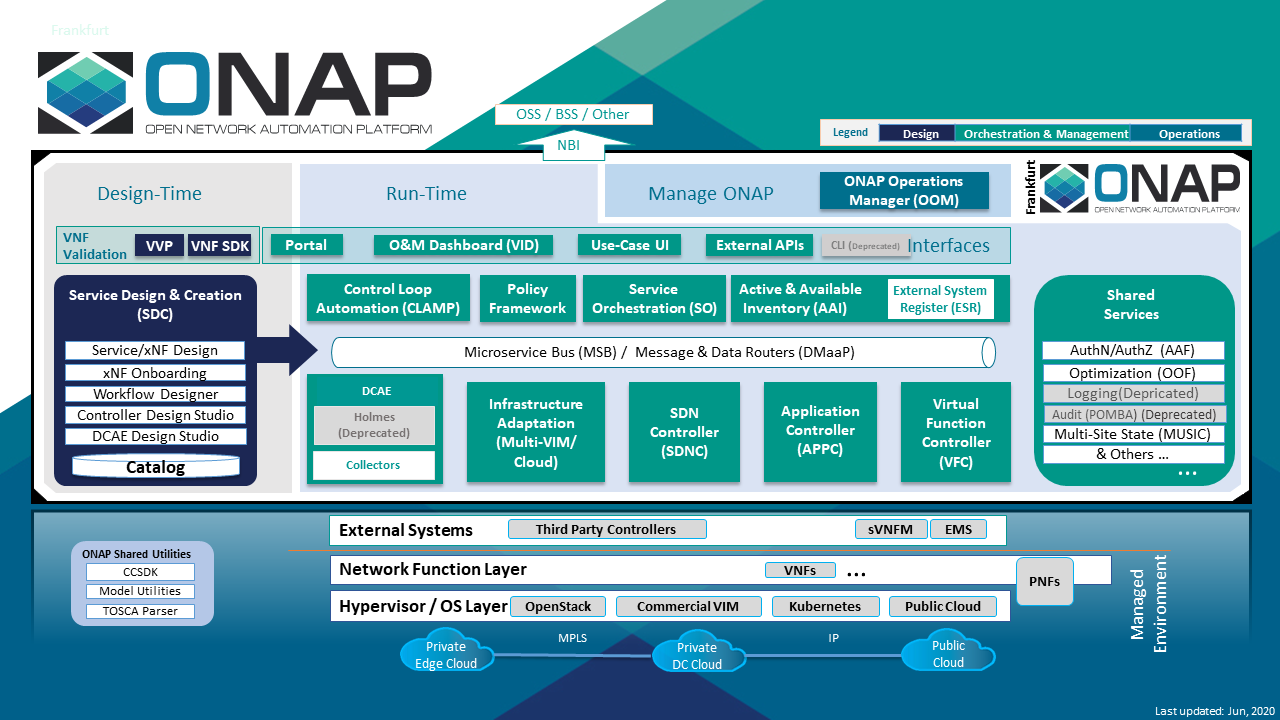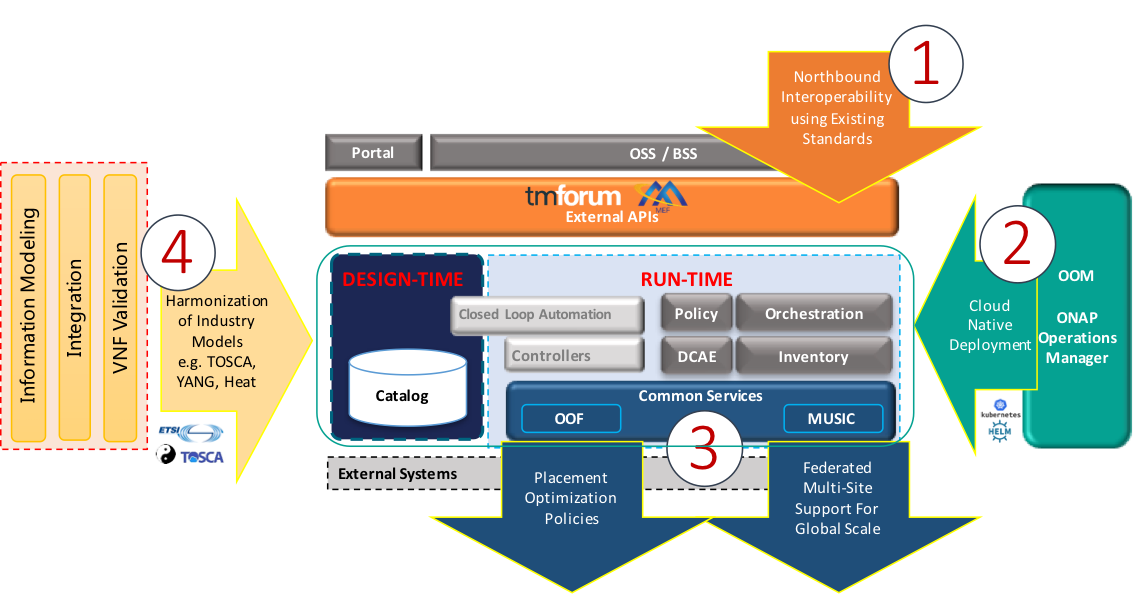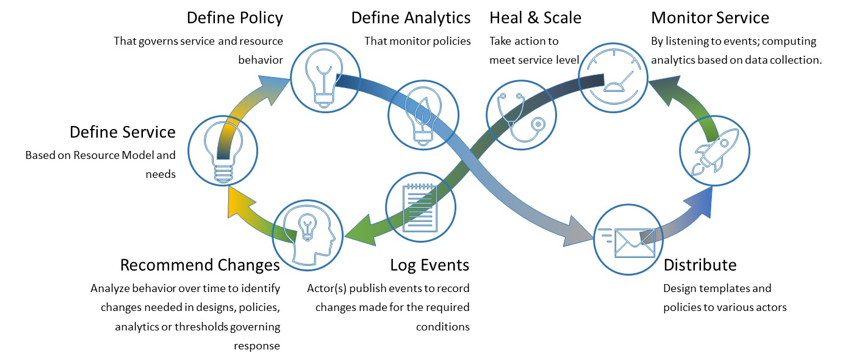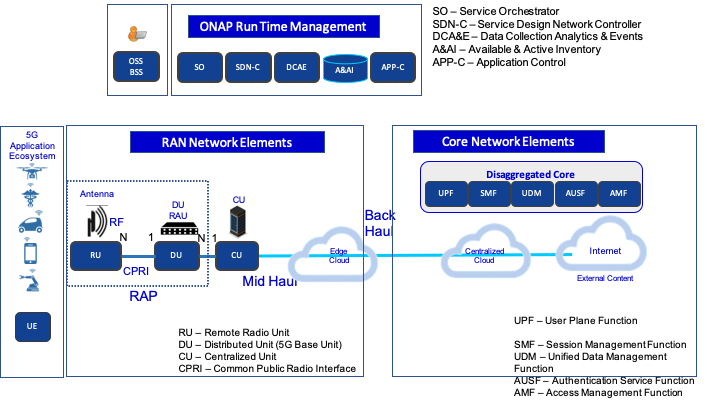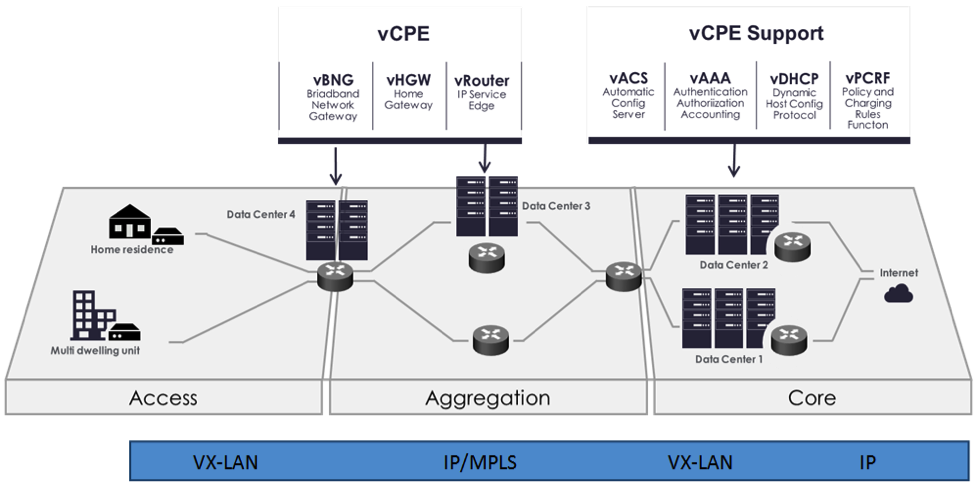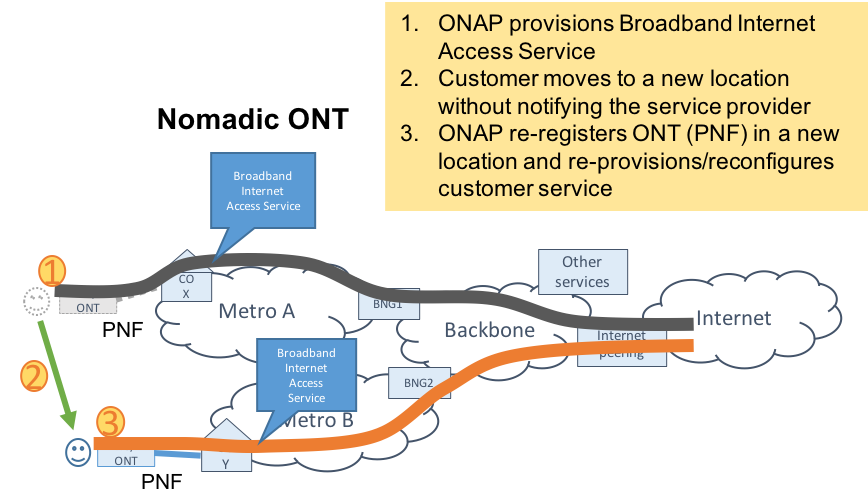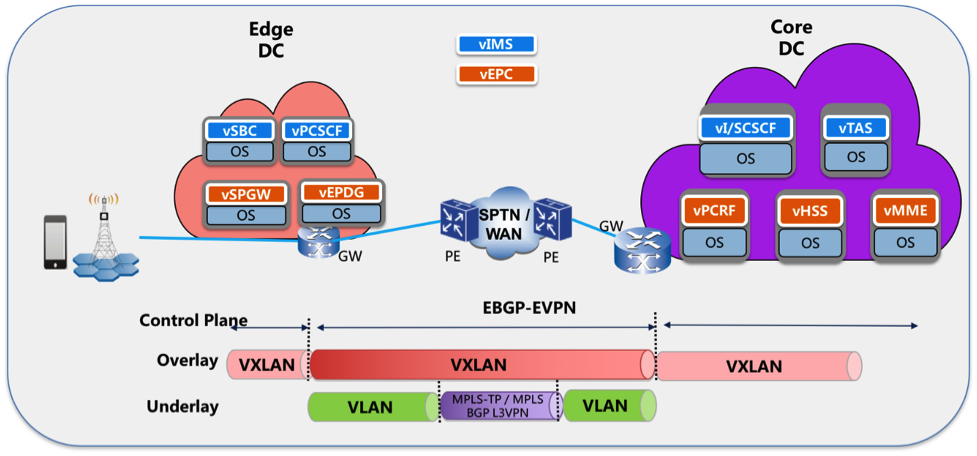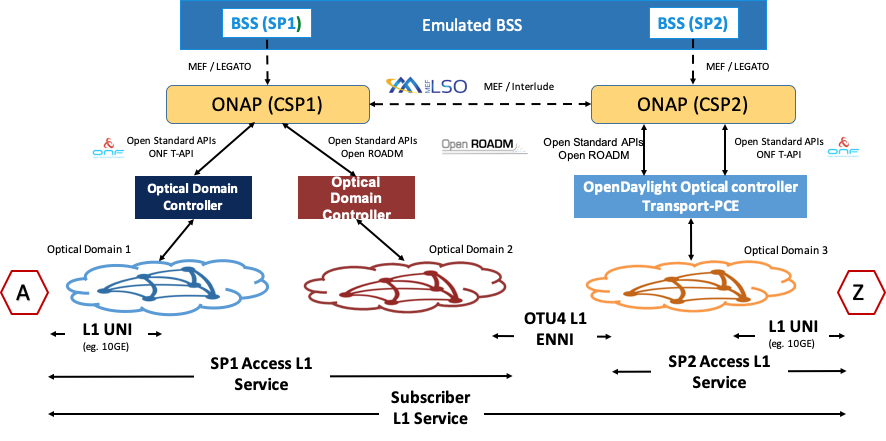Introduction¶
The ONAP project addresses the rising need for a common automation platform for telecommunication, cable, and cloud service providers—and their solution providers—to deliver differentiated network services on demand, profitably and competitively, while leveraging existing investments.
The challenge that ONAP meets is to help operators of telecommunication networks to keep up with the scale and cost of manual changes required to implement new service offerings, from installing new data center equipment to, in some cases, upgrading on-premises customer equipment. Many are seeking to exploit SDN and NFV to improve service velocity, simplify equipment interoperability and integration, and to reduce overall CapEx and OpEx costs. In addition, the current, highly fragmented management landscape makes it difficult to monitor and guarantee service-level agreements (SLAs). These challenges are still very real now as ONAP creates its fourth release.
ONAP is addressing these challenges by developing global and massive scale (multi-site and multi-VIM) automation capabilities for both physical and virtual network elements. It facilitates service agility by supporting data models for rapid service and resource deployment and providing a common set of northbound REST APIs that are open and interoperable, and by supporting model-driven interfaces to the networks. ONAP’s modular and layered nature improves interoperability and simplifies integration, allowing it to support multiple VNF environments by integrating with multiple VIMs, VNFMs, SDN Controllers, as well as legacy equipment (PNF). ONAP’s consolidated xNF requirements publication enables commercial development of ONAP-compliant xNFs. This approach allows network and cloud operators to optimize their physical and virtual infrastructure for cost and performance; at the same time, ONAP’s use of standard models reduces integration and deployment costs of heterogeneous equipment. All this is achieved while minimizing management fragmentation.
The ONAP platform allows end-user organizations and their network/cloud providers to collaboratively instantiate network elements and services in a rapid and dynamic way, together with supporting a closed control loop process that supports real-time response to actionable events. In order to design, engineer, plan, bill and assure these dynamic services, there are three major requirements:
- A robust design framework that allows the specification of the service in all aspects – modeling the resources and relationships that make up the service, specifying the policy rules that guide the service behavior, specifying the applications, analytics and closed control loop events needed for the elastic management of the service
- An orchestration and control framework (Service Orchestrator and Controllers ) that is recipe/ policy-driven to provide an automated instantiation of the service when needed and managing service demands in an elastic manner
- An analytic framework that closely monitors the service behavior during the service lifecycle based on the specified design, analytics and policies to enable response as required from the control framework, to deal with situations ranging from those that require healing to those that require scaling of the resources to elastically adjust to demand variations.
To achieve this, ONAP decouples the details of specific services and supporting technologies from the common information models, core orchestration platform, and generic management engines (for discovery, provisioning, assurance etc.). Furthermore, it marries the speed and style of a DevOps/NetOps approach with the formal models and processes operators require to introduce new services and technologies. It leverages cloud-native technologies including Kubernetes to manage and rapidly deploy the ONAP platform and related components. This is in stark contrast to traditional OSS/Management software platform architectures, which hardcoded services and technologies, and required lengthy software development and integration cycles to incorporate changes.
The ONAP Platform enables service/resource independent capabilities for design, creation and lifecycle management, in accordance with the following foundational principles:
- Ability to dynamically introduce full service lifecycle orchestration (design ,provisioning and operation) and service API for new services and technologies without the need for new platform software releases or without affecting operations for the existing services
- Carrier-grade scalability including horizontal scaling (linear scale-out) and distribution to support a large number of services and large networks
- Metadata-driven and policy-driven architecture to ensure flexible and automated ways in which capabilities are used and delivered
- The architecture shall enable sourcing best-in-class components
- Common capabilities are ‘developed’ once and ‘used’ many times
- Core capabilities shall support many diverse services and infrastructures
Further, ONAP comes with a functional architecture with component definitions and interfaces, which provides a force of industry alignment in addition to the open source code.
ONAP Architecture¶
The ONAP architecture consists of a design time and run time functions, as well as functions for managing ONAP itself.
Figure 1 provides a high-level view of the ONAP architecture with its microservices-based platform components.
Figure 2 below, provides a simplified functional view of the architecture, which highlights the role of a few key components:
- Design time environment for onboarding services and resources into ONAP and designing required services.
- External API provides northbound interoperability for the ONAP Platform and Multi-VIM/Cloud provides cloud interoperability for the ONAP workloads.
- OOM provides the ability to manage cloud-native installation and deployments to Kubernetes-managed cloud environments.
- ONAP Shared Services provides shared capabilities for ONAP modules. MUSIC allows ONAP to scale to multi-site environments to support global scale infrastructure requirements. The ONAP Optimization Framework (OOF) provides a declarative, policy-driven approach for creating and running optimization applications like Homing/Placement, and Change Management Scheduling Optimization. Logging provides centralized logging capabilities, Audit (POMBA) provides capabilities to understand orchestration actions.
- ONAP shared utilities provide utilities for the support of the ONAP components.
- Information Model and framework utilities continue to evolve to harmonize the topology, workflow, and policy models from a number of SDOs including ETSI NFV MANO, TM Forum SID, ONF Core, OASIS TOSCA, IETF, and MEF.
Figure 2. Functional view of the ONAP architecture
Microservices Support¶
As a cloud-native application that consists of numerous services, ONAP requires sophisticated initial deployment as well as post- deployment management.
The ONAP deployment methodology needs to be flexible enough to suit the different scenarios and purposes for various operator environments. Users may also want to select a portion of the ONAP components to integrate into their own systems. And the platform needs to be highly reliable, scalable, secure and easy to manage. To achieve all these goals, ONAP is designed as a microservices-based system, with all components released as Docker containers following best practice building rules to optimize their image size. To reduce the ONAP footprint, a first effort to use shared data base have been initiated with a Cassandra and mariadb-galera clusters.
The ONAP Operations Manager (OOM) is responsible for orchestrating the end-to-end lifecycle management and monitoring of ONAP components. OOM uses Kubernetes to provide CPU efficiency and platform deployment. In addition, OOM helps enhance ONAP platform maturity by providing scalability and resiliency enhancements to the components it manages.
OOM is the lifecycle manager of the ONAP platform and uses the Kubernetes container management system and Consul to provide the following functionality:
- Deployment - with built-in component dependency management (including multiple clusters, federated deployments across sites, and anti-affinity rules)
- Configuration - unified configuration across all ONAP components
- Monitoring - real-time health monitoring feeding to a Consul GUI and Kubernetes
- Restart - failed ONAP components are restarted automatically
- Clustering and Scaling - cluster ONAP services to enable seamless scaling
- Upgrade - change out containers or configuration with little or no service impact
- Deletion - clean up individual containers or entire deployments
OOM supports a wide variety of cloud infrastructures to suit your individual requirements.
Microservices Bus (MSB) provides fundamental microservices supports including service registration/ discovery, external API gateway, internal API gateway, client software development kit (SDK), and Swagger SDK. When integrating with OOM, MSB has a Kube2MSB registrar which can grasp services information from k8s metafile and automatically register the services for ONAP components.
In the spirit of leveraging the microservice capabilities, further steps towards increased modularity have been taken. Service Orchestrator (SO) and the controllers have increased its level of modularity.
Portal¶
ONAP delivers a single, consistent user experience to both design time and runtime environments, based on the user’s role. Role changes are configured within a single ONAP instance.
This user experience is managed by the ONAP Portal, which provides access to design, analytics and operational control/administration functions via a shared, role-based menu or dashboard. The portal architecture provides web-based capabilities such as application onboarding and management, centralized access management through the Authentication and Authorization Framework (AAF), and dashboards, as well as hosted application widgets.
The portal provides an SDK to enable multiple development teams to adhere to consistent UI development requirements by taking advantage of built-in capabilities (Services/ API/ UI controls), tools and technologies. ONAP also provides a Command Line Interface (CLI) for operators who require it (e.g., to integrate with their scripting environment). ONAP SDKs enable operations/security, third parties (e.g., vendors and consultants), and other experts to continually define/redefine new collection, analytics, and policies (including recipes for corrective/remedial action) using the ONAP Design Framework Portal.
Design Time Framework¶
The design time framework is a comprehensive development environment with tools, techniques, and repositories for defining/ describing resources, services, and products.
The design time framework facilitates reuse of models, further improving efficiency as more and more models become available. Resources, services, products, and their management and control functions can all be modeled using a common set of specifications and policies (e.g., rule sets) for controlling behavior and process execution. Process specifications automatically sequence instantiation, delivery and lifecycle management for resources, services, products and the ONAP platform components themselves. Certain process specifications (i.e., ‘recipes’) and policies are geographically distributed to optimize performance and maximize autonomous behavior in federated cloud environments.
Service Design and Creation (SDC) provides tools, techniques, and repositories to define/simulate/certify system assets as well as their associated processes and policies. Each asset is categorized into one of four asset groups: Resource, Services, Products, or Offers. SDC also supports TOSCA1.3 List type definition which provides the ability to design complicated service descriptor.
The SDC environment supports diverse users via common services and utilities. Using the design studio, product and service designers onboard/extend/retire resources, services and products. Operations, Engineers, Customer Experience Managers, and Security Experts create workflows, policies and methods to implement Closed control Loop Automation/Control and manage elastic scalability.
To support and encourage a healthy VNF ecosystem, ONAP provides a set of VNF packaging and validation tools in the VNF Supplier API and Software Development Kit (VNF SDK) and VNF Validation Program (VVP) components. Vendors can integrate these tools in their CI/CD environments to package VNFs and upload them to the validation engine. Once tested, the VNFs can be onboarded through SDC. In addition, the testing capability of VNFSDK is being utilized at the LFN Compliance Verification Program to work towards ensuring a highly consistent approach to VNF verification.
The Policy Creation component deals with policies; these are rules, conditions, requirements, constraints, attributes, or needs that must be provided, maintained, and/or enforced. At a lower level, Policy involves machine-readable rules enabling actions to be taken based on triggers or requests. Policies often consider specific conditions in effect (both in terms of triggering specific policies when conditions are met, and in selecting specific outcomes of the evaluated policies appropriate to the conditions).
Policy allows rapid modification through easily updating rules, thus updating technical behaviors of components in which those policies are used, without requiring rewrites of their software code. Policy permits simpler management / control of complex mechanisms via abstraction.
Runtime Framework¶
The runtime execution framework executes the rules and policies and other models distributed by the design and creation environment.
This allows for the distribution of models and policy among various ONAP modules such as the Service Orchestrator (SO), Controllers, Data Collection, Analytics and Events (DCAE), Active and Available Inventory (A&AI). These components use common services that support logging, access control, Multi-Site State Coordination (MUSIC), which allow the platform to register and manage state across multi-site deployments.
Orchestration¶
The Service Orchestrator (SO) component executes the specified processes by automating sequences of activities, tasks, rules and policies needed for on-demand creation, modification or removal of network, application or infrastructure services and resources, this includes VNFs, CNFs and PNFs. The SO provides orchestration at a very high level, with an end-to-end view of the infrastructure, network, and applications.
One is BroadBand Service (BBS), the second one is Cross Domain and Cross Layer VPN (CCVPN).
Virtual Infrastructure Deployment (VID)¶
The Virtual Infrastructure Deployment (VID) application enables users to instantiate infrastructure services from SDC, along with their associated components, and to execute change management operations such as scaling and software upgrades to existing VNF instances.
Policy-Driven Workload Optimization¶
The ONAP Optimization Framework (OOF) provides a policy-driven and model-driven framework for creating optimization applications for a broad range of use cases. OOF Homing and Allocation Service (HAS) is a policy driven workload optimization service that enables optimized placement of services across multiple sites and multiple clouds, based on a wide variety of policy constraints including capacity, location, platform capabilities, and other service specific constraints.
ONAP Multi-VIM/Cloud (MC) and several other ONAP components such as Policy, SO, A&AI etc. play an important role in enabling “Policy-driven Performance/Security-Aware Adaptive Workload Placement/ Scheduling” across cloud sites through OOF-HAS. OOF-HAS uses Hardware Platform Awareness (HPA), cloud agnostic Intent capabilities, and real-time capacity checks provided by ONAP MC to determine the optimal VIM/Cloud instances, which can deliver the required performance SLAs, for workload (VNF etc.) placement and scheduling (Homing). Operators now realize the true value of virtualization through fine grained optimization of cloud resources while delivering performance and security SLAs.
Controllers¶
Controllers are applications which are coupled with cloud and network services and execute the configuration, real-time policies, and control the state of distributed components and services. Rather than using a single monolithic control layer, operators may choose to use multiple distinct controller types that manage resources in the execution environment corresponding to their assigned controlled domain such as cloud computing resources (network configuration (SDN-C) and application (App-C). The App-C and SDN-C also support the Virtual Function Controller (VF-C) provides an ETSI NFV compliant NFV-O function that is responsible for lifecycle management of virtual services and the associated physical COTS server infrastructure. VF-C provides a generic VNFM capability but also integrates with external VNFMs and VIMs as part of an NFV MANO stack.
Inventory¶
Active and Available Inventory (A&AI) provides real-time views of a system’s resources, services, products and their relationships with each other, and also retains a historical view. The views provided by A&AI relate data managed by multiple ONAP instances, Business Support Systems (BSS), Operation Support Systems (OSS), and network applications to form a “top to bottom” view ranging from the products end users buy, to the resources that form the raw material for creating the products. A&AI not only forms a registry of products, services, and resources, it also maintains up-to-date views of the relationships between these inventory items.
To deliver the promised dynamism of SDN/NFV, A&AI is updated in real time by the controllers as they make changes in the network environment. A&AI is metadata-driven, allowing new inventory types to be added dynamically and quickly via SDC catalog definitions, eliminating the need for lengthy development cycles.
Policy Framework¶
The Policy framework provides policy based decision making capability and supports multiple policy engines and can distribute policies through policy design capabilities in SDC, simplifying the design process.
Multi Cloud Adaptation¶
Multi-VIM/Cloud provides and infrastructure adaptation layer for VIMs/Clouds in exposing advanced hardware platform awareness and cloud agnostic intent capabilities, besides standard capabilities, which are used by OOF and other components for enhanced cloud selection and SO/VF-C for cloud agnostic workload deployment.
Closed Control Loop Automation¶
Closed loop control is provided by cooperation among a number of design-time and run-time elements. The Runtime loop starts with data collectors from Data Collection, Analytics and Events (DCAE). ONAP includes the following collectors: VES for events, HV-VES for high-volume events, SNMP for SNMP traps, File Collector to receive files, and Restconf Collector to collect the notifications. After data collection/verification phase, data are moved through the loop of micro-services like Homes for event detection, Policy for determining actions, and finally, controllers and orchestrators to implement actions CLAMP is used to monitor the loops themselves. DCAE also supports (Platform for Network Data Analytics) PNDA analytics capabilities. CLAMP, Policy and DCAE all have design time aspects to support the creation of the loops.
We refer to this automation pattern as “closed control loop automation” in that it provides the necessary automation to proactively respond to network and service conditions without human intervention. A high-level schematic of the “closed control loop automation” and the various phases within the service lifecycle using the automation is depicted in Figure 3.
Closed control loop control is provided by Data Collection, Analytics and Events (DCAE) and one or more of the other ONAP runtime components. Collectively, they provide FCAPS (Fault Configuration Accounting Performance Security) functionality. DCAE collects performance, usage, and configuration data; provides computation of analytics; aids in troubleshooting; and publishes events, data and analytics (e.g., to policy, orchestration, and the data lake). Another component, “Holmes”, connects to DCAE and provides alarm correlation for ONAP, new data collection capabilities with High Volume VES, and bulk performance management support.
Working with the Policy Framework and CLAMP, these components detect problems in the network and identify the appropriate remediation. In some cases, the action will be automatic, and they will notify Service Orchestrator or one of the controllers to take action. In other cases, as configured by the operator, they will raise an alarm but require human intervention before executing the change. The policy framework is extended to support additional policy decision capabilities with the introduction of adaptive policy execution.
Figure 3: ONAP Closed Control Loop Automation
ONAP Modeling¶
ONAP provides models to assist with service design, the development of ONAP service components, and with the improvement of standards interoperability.
Models are an essential part for the design time and runtime framework development. The ONAP modeling project leverages the experience of member companies, standard organizations and other open source projects to produce models which are simple, extensible, and reusable. The goal is to fulfill the requirements of various use cases, guide the development and bring consistency among ONAP components and explore a common model to improve the interoperability of ONAP.
ONAP supports various models detailed in Modeling Documentation.
The modeling project includes the ETSI catalog component, which provides the parser functionalities, as well as additional package management functionalities.
Industry Alignment¶
ONAP support and collaboration with other standards and open source communities is evident in the architecture.
- MEF and TMF interfaces are used in the External APIs
- In addition to the ETSI-NFV defined VNFD and NSD models mentioned above, ONAP supports the NFVO interfaces (SOL005 between the SO and VFC, SOL003 from either the SO or VFC to an external VNFM).
- Further collaboration includes 5G/ORAN & 3GPP Harmonization, Acumos DCAE Integration, and CNCF Telecom User Group (TUG).
Read this whitepaper for more information: The Progress of ONAP: Harmonizing Open Source and Standards.
ONAP Blueprints¶
ONAP can support an unlimited number of use cases, within reason. However, to provide concrete examples of how to use ONAP to solve real-world problems, the community has created a set of blueprints. In addition to helping users rapidly adopt the ONAP platform through end-to-end solutions, these blueprints also help the community prioritize their work. With the ONAP Frankfurt release, we introduced a new blueprint in the area of optical transport networking called Multi-Domain Optical Network Service (MDONS). Prior blueprints were vCPE, VoLTE, vFW/vDNS, 5G, and CCVPN. 5G and CCVPN underwent feature enhancements during the Frankfurt release.
5G Blueprint¶
The 5G blueprint is a multi-release effort, with five key initiatives around end-to-end service orchestration, network slicing, PNF/VNF lifecycle management , PNF integration, and network optimization. The combination of eMBB that promises peak data rates of 20 Mbps, uRLLC that guarantees sub-millisecond response times, MMTC that can support 0.92 devices per sq. ft., and network slicing brings with it some unique requirements. First ONAP needs to manage the lifecycle of a network slice from initial creation/activation all the way to deactivation/termination. Next, ONAP needs to optimize the network around real time and bulk analytics, place VNFs on the correct edge cloud, scale and heal services, and provide edge automation. ONAP also provides self organizing network (SON) services such as physical cell ID allocation for new RAN sites. These requirements have led to the five above-listed initiatives and have been developed in close cooperation with other standards and open source organizations such as 3GPP, TM Forum, ETSI, and O-RAN Software Community.
Figure 4. End-to-end 5G Service
Read the 5G Blueprint to learn more.
Residential Connectivity Blueprints¶
Two ONAP blueprints (vCPE and BBS) address the residential connectivity use case.
Virtual CPE (vCPE)¶
Currently, services offered to a subscriber are restricted to what is designed into the broadband residential gateway. In the blueprint, the customer has a slimmed down physical CPE (pCPE) attached to a traditional broadband network such as DSL, DOCSIS, or PON (Figure 5). A tunnel is established to a data center hosting various VNFs providing a much larger set of services to the subscriber at a significantly lower cost to the operator. In this blueprint, ONAP supports complex orchestration and management of open source VNFs and both virtual and underlay connectivity.
Figure 5. ONAP vCPE Architecture
Read the Residential vCPE Use Case with ONAP blueprint to learn more.
Broadband Service (BBS)¶
This blueprint provides multi-gigabit residential internet connectivity services based on PON (Passive Optical Network) access technology. A key element of this blueprint is to show automatic re-registration of an ONT (Optical Network Terminal) once the subscriber moves (nomadic ONT) as well as service subscription plan changes. This blueprint uses ONAP for the design, deployment, lifecycle management, and service assurance of broadband services. It further shows how ONAP can orchestrate services across different locations (e.g. Central Office, Core) and technology domains (e.g. Access, Edge).
Figure 6. ONAP BBS Architecture
Read the Residential Connectivity Blueprint to learn more.
Voice over LTE (VoLTE) Blueprint¶
This blueprint uses ONAP to orchestrate a Voice over LTE service. The VoLTE blueprint incorporates commercial VNFs to create and manage the underlying vEPC and vIMS services by interworking with vendor-specific components, including VNFMs, EMSs, VIMs and SDN controllers, across Edge Data Centers and a Core Data Center. ONAP supports the VoLTE use case with several key components: SO, VF-C, SDN-C, and Multi-VIM/ Cloud. In this blueprint, SO is responsible for VoLTE end-to-end service orchestration working in collaboration with VF-C and SDN-C. SDN-C establishes network connectivity, then the VF-C component completes the Network Services and VNF lifecycle management (including service initiation, termination and manual scaling) and FCAPS (fault, configuration, accounting, performance, security) management. This blueprint also shows advanced functionality such as scaling and change management.
Figure 7. ONAP VoLTE Architecture Open Network Automation Platform
Read the VoLTE Blueprint to learn more.
Optical Transport Networking (OTN)¶
Two ONAP blueprints (CCVPN and MDONS) address the OTN use case. CCVPN addresses Layers 2 and 3, while MDONS addresses Layers 0 and 1.
CCVPN (Cross Domain and Cross Layer VPN) Blueprint¶
CSPs, such as CMCC and Vodafone, see a strong demand for high-bandwidth, flat, high-speed OTN (Optical Transport Networks) across carrier networks. They also want to provide a high-speed, flexible and intelligent service for high-value customers, and an instant and flexible VPN service for SMB companies.
Figure 8. ONAP CCVPN Architecture
The CCVPN (Cross Domain and Cross Layer VPN) blueprint is a combination of SOTN (Super high-speed Optical Transport Network) and ONAP, which takes advantage of the orchestration ability of ONAP, to realize a unified management and scheduling of resources and services. It achieves cross-domain orchestration and ONAP peering across service providers. In this blueprint, SO is responsible for CCVPN end-to-end service orchestration working in collaboration with VF-C and SDN-C. SDN-C establishes network connectivity, then the VF-C component completes the Network Services and VNF lifecycle management. ONAP peering across CSPs uses an east-west API which is being aligned with the MEF Interlude API. The key innovations in this use case are physical network discovery and modeling, cross-domain orchestration across multiple physical networks, cross operator end-to-end service provisioning, close-loop reroute for cross-domain service, dynamic changes (branch sites, VNFs) and intelligent service optimization (including AI/ML). The Frankfurt release adds support for end-to-end E-LINE services over optical transport network (OTN) network-to-network interface (NNI).
Read the CCVPN Blueprint to learn more.
MDONS (Multi-Domain Optical Network Service) Blueprint¶
While CCVPN addresses the automation of networking layers 2 and 3, it does not address layers 0 and 1. Automating these layers is equally important because providing an end-to-end service to their customers often requires a manual and complex negotiation between CSPs that includes both the business arrangement and the actual service design and activation. CSPs may also be structured such that they operate multiple networks independently and require similar transactions among their own networks and business units in order to provide an end-to-end service. The MDONS blueprint created by AT&T, Orange, and Fujitsu solves the above problem. MDONS and CCVPN used together can solve the OTN automation problem in a comprehensive manner.
Figure 9. ONAP MDONS Architecture
vFW/vDNS Blueprint¶
The virtual firewall, virtual DNS blueprint is a basic demo to verify that ONAP has been correctly installed and to get a basic introduction to ONAP. The blueprint consists of 5 VNFs: vFW, vPacketGenerator, vDataSink, vDNS and vLoadBalancer. The blueprint exercises most aspects of ONAP, showing VNF onboarding, network service creation, service deployment and closed-loop automation. The key components involved are SDC, CLAMP, SO, APP-C, DCAE and Policy. In the recent releases, the vFW blueprint has been demonstrated by using a mix of a CNF and VNF and entirely using CNFs.
Verified end to end tests¶
Use cases¶
Various use cases have been tested for the Release. Detailed information can be found in Verified Use Cases.
- vFirewall with closed loop
- vFirewall/vDNS with HPA
- vFirewall In-Place Software Upgrade with Traffic Distribution
- vFirewall CNF With CDS
- Scale Out
- CCVPN-E LINE over OTN NNI
- CCVPN - MDONS
- BBS (Broadband Service)
- vFirewall CNF with multicloud k8s plugin
- EdgeXFoundry CNF with multicloud k8s plugin
- vCPE with Tosca
- E2E Automation vLB with CDS
Functional requirements¶
Various functional requirements have been tested for the Release. Detailed information can be found in Verified Use Cases.
- PNF Software Upgrade using direct Netconf Yang interface with PNF
- PNF Software Upgrade with EM with Ansible
- PNF Software Upgrade with EM with Netconf
- VSP Compliance and Validation Check within SDC
- Enable PNF software version at onboarding
- xNF communication security enhancements
- ETSI Alignment SO plugin to support SOL003 to connect to an external VNFM
- Integration of CDS as an Actor
- 3rd Party Operational Domain Manager
- Configuration & persistency
- 5G functional requirements
- 5G Realtime PM and High Volume Stream Data Collection
- 5G PNF Plug and Play
- 5G Bulk PM
- 5G OOF and PCI
- 5G NRM Network Resource Model (Configuration management)
- 5G NETCONF configuration
- 5G PNF Pre-Onboarding & Onboarding
- 5G OOF SON
- 5G E2E Network Slicing
- 5G ORAN A1 Adapter (SDNR)
Conclusion¶
The ONAP platform provides a comprehensive platform for real-time, policy-driven orchestration and automation of physical and virtual network functions that will enable software, network, IT and cloud providers and developers to rapidly automate new services and support complete lifecycle management.
By unifying member resources, ONAP will accelerate the development of a vibrant ecosystem around a globally shared architecture and implementation for network automation—with an open standards focus— faster than any one product could on its own.
